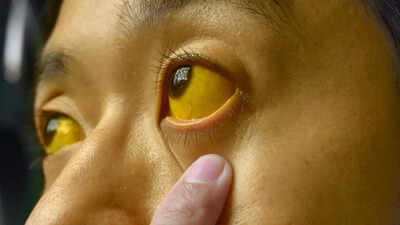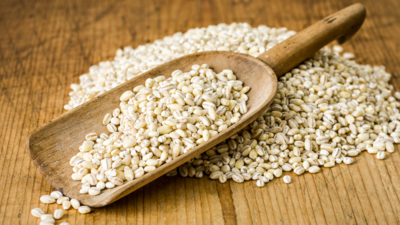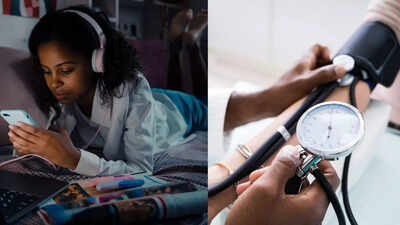Jaundice, the yellowing of skin and eyes: Why it happens |

Jaundice is a condition where the skin and the whites of the eyes turn yellow due to a buildup of a substance called bilirubin. Bilirubin is a yellow pigment that forms when the body breaks down old red blood cells. Normally, the liver filters out bilirubin and removes it through bile in the stool and urine. But when something goes wrong, like liver disease, blocked bile ducts, or rapid red blood cell breakdown, bilirubin can build up in the blood. This excess pigment then settles into the skin and eyes, leading to the yellow colouring known as jaundice.
What causes the yellowing in jaundice?
The yellowing in jaundice is caused by the buildup of a yellow-orange substance called bilirubin. This pigment is produced when your body breaks down old red blood cells. Normally, the liver processes bilirubin and eliminates it from the body through bile, which exits via the stool and urine.But when there’s a disruption in this process due to disease, injury, or obstruction, bilirubin can accumulate in the bloodstream and tissues. When levels become too high, it starts to deposit in parts of the body, especially the skin and eyes, leading to the yellow appearance we call jaundice.
Why does the skin turn yellow in jaundice?
The skin becomes yellow because bilirubin builds up in fat-rich tissues, and skin has a significant amount of fat. As bilirubin circulates through the blood, it gets absorbed into the skin, causing a visible colour change. The more bilirubin in the body, the more pronounced the yellowing becomes.This change can vary in intensity depending on the cause of jaundice and how quickly the bilirubin levels are rising. In some people, especially those with lighter skin tones, it may be easier to notice the yellowing early.
What makes your eyes turn yellow first in jaundice?
The whites of the eyes, known as the sclera, often show signs of jaundice before the skin does. This is because the tissue in the eyes is thinner and more transparent than skin, making it easier to see the yellow pigment. Even a mild increase in bilirubin can cause a noticeable change in the eye colour.This condition is called scleral icterus, and it can be one of the earliest signs of liver or bile duct problems. Though the yellowing itself doesn’t usually affect vision, it is a strong signal that something may be wrong with your body’s ability to process and remove waste products like bilirubin.
The three main types of jaundice
Jaundice is generally divided into three types, depending on where the problem occurs: before the liver, inside the liver, or after the liver.
Pre-hepatic jaundice (before the liver)
This type occurs when there is excessive breakdown of red blood cells, producing more bilirubin than the liver can handle. The liver is still healthy, but it becomes overwhelmed by the high volume of waste.Common causes include:
- Haemolytic anaemia
- Sickle cell disease
- Malaria
The rapid destruction of red blood cells increases bilirubin levels in the blood, leading to jaundice.
Hepatic jaundice (inside the liver)
In this type, the problem lies within the liver itself. If the liver cells are damaged, they can’t properly process or get rid of bilirubin.Common causes include:
- Hepatitis (viral or autoimmune)
- Alcohol-related liver disease
- Liver cirrhosis
- Drug-induced liver injury
Because the liver is not functioning efficiently, bilirubin leaks into the bloodstream, causing the yellowing of skin and eyes.
Post-hepatic jaundice (after the liver)
Also known as obstructive jaundice, this type happens when there’s a blockage in the bile ducts. Although the liver produces bilirubin normally, it cannot exit the body due to the blockage.Common causes include:
- Gallstones
- Pancreatic cancer
- Tumours or narrowing of the bile ducts
As bile builds up, bilirubin is pushed back into the bloodstream, leading to jaundice.
Other symptoms that may appear with jaundice
In addition to yellowing of the skin and eyes, people with jaundice may notice:
- Dark-coloured urine (due to excess bilirubin being filtered by the kidneys)
- Pale or clay-coloured stools (lack of bilirubin in the digestive system)
- Fatigue or general weakness
- Loss of appetite or nausea
- Itchy skin (caused by bile salts building up in the body)
- Abdominal discomfort, especially in the upper right side of the belly
The severity and combination of these symptoms often depend on the underlying cause of jaundice and how quickly it develops.
When to seek medical help
While jaundice is often harmless in newborns and may go away on its own, in adults it can signal a serious health issue. Seek medical help if you notice sudden or deep yellowing of the skin or eyes, especially if it comes with severe belly pain, fever, vomiting, loss of appetite, fatigue, or confusion. These may point to problems with the liver, gallbladder, or pancreas. In babies, jaundice should always be checked by a doctor, as high bilirubin levels can lead to serious complications if left untreated. Prompt medical care is key to safe recovery.Jaundice is your body’s way of signalling that something is not working properly, whether it’s red blood cell breakdown, liver function, or bile flow. The yellowing starts subtly, often with the eyes, but can quickly progress if left untreated. Understanding the root cause is key. Once doctors identify where the problem lies, they can treat the underlying condition and bring bilirubin levels back to normal. If you notice yellowing in yourself or someone else, don’t ignore it. Early diagnosis and timely treatment can prevent complications and protect your liver and overall health.Also Read: Don’t ignore these 5 eye symptoms, as they could point to kidney disease






